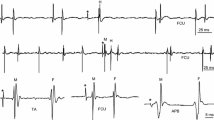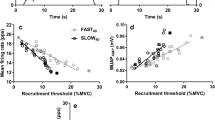Abstract
The primary purpose of this study was to examine if there are changes in the intrinsic properties of spinal motoneurons after prolonged submaximal contractions. To do this, we assessed whether or not the synaptic drive to motoneurons needs to increase in order to maintain a constant firing rate of a motor unit. Recruitment of new units and an increase in total electromyographic (EMG) activity of the muscle of interest were taken as estimates of an increase in synaptic drive. Subjects were asked to maintain a constant firing rate of a clearly identifiable (targeted) motor unit from the first dorsal interosseous muscle for approximately 10 min, while surface EMG and force were recorded simultaneously. For the 60 units studied, the duration of the constant-firing-rate period ranged from 73 to 1,140 s (448 ± 227 s; mean ± SD). There was a significant increase (t-test, p<0.001) in the magnitude of mean surface EMG, and DC force while the targeted motoneuron maintained a constant rate suggesting an increase in the net excitatory input to the motoneuron pool. Changes occurring simultaneously in other parameters, namely, variability in interspike interval, magnitude of force fluctuations, the duration of motor unit action potentials, and the median power frequency of surface EMG were also computed. The firing rates of 16 concurrently firing motoneurons, not controlled by the subject, remained constant. The key finding of this study is that after prolonged activity, a motoneuron requires a stronger excitatory input to maintain its firing rate. Additional results are indicative of significant changes in the characteristics of the synaptic inputs, changes at the neuromuscular junction (both pre- and postsynaptic regions) and the sarcolemma.





Similar content being viewed by others
References
Antonov I, Antonova I, Kandel ER, Hawkins RD (2003) Activity-dependent presynaptic facilitation and hebbian LTP are both required and interact during classical conditioning in Aplysia. Neuron 37:135–147
Baldissera F, Campadelli P, Piccinelli L (1987) The dynamic response of cat gastrocnemius motor units investigated by ramp-current injection into their motoneurones. J Physiol 387:317–330
Bigland-Ritchie B, Johansson RS, Lippold OJC, Smith S, Woods JJ (1983) Changes in motoneuron firing rates during sustained maximal voluntary contractions. J Physiol 340:335–346
Bigland-Ritchie B, Cafarelli E, Vøllestad NK (1986) Fatigue of submaximal static contractions. Acta Physiol Scand 128 (Suppl 556):137–148
Calvin WH, Stevens CF (1968) Synaptic noise and other sources of randomness in motoneuron interspike interval. J Neurophysiol 31:574–587
Carpentier A, Duchateau J, Hainaut K (2001) Motor unit behaviour and contractile changes during fatigue in human first dorsal interosseous. J Physiol 534:903–912
De Luca CJ (1984) Myoelectric manifestations of localized muscular fatigue in humans. CRC Crit Rev Biomed Eng 11:251–279
De Luca CJ, LeFever RS, McCue MP, Xenakis AP (1982) Control scheme governing concurrently active motor units during voluntary contractions. J Physiol 329:129–142
Duchateau J, Balestra C, Carpentier A, Hainaut K (2002) Reflex regulation during sustained and intermittent submaximal contractions in humans. J Physiol 541:959–967
Enoka RM, Robinson GA, Kossev AR (1989) Task and fatigue effects on low-threshold motor units in human hand muscle. J Neurophysiol 62:1344–1359
Fuglevand AJ, Winter DA, Patla AE, Stashuk D (1989) Effect of increased motor unit action potential duration on the amplitude and median power frequency of the electromyogram. IEEE Engineering in Medicine & Biology, Proceedings of 11th annual conference, pp 953–954
Gandevia SC, Macefield VG, Burke D, McKenzie DK (1990) Voluntary activation of human motor axons in the absence of muscle afferent feedback. Brain 113:1563–1581
Garland SJ, Enoka RM, Serrano LP, Robinson GA (1994) Behavior of motor units in human biceps brachii during a submaximal fatiguing contraction. J Appl Physiol 76:2411–2419
Gatev P, Ivanova T, Gantchev GN (1986) Changes in firing pattern of high threshold motor units due to fatigue. Electromyog Clin Neurophysiol 26:83–93
Halliday DM, Conway BA, Farmer SF, Rosenberg JR (1999) Load-independent contributions from motor-unit synchronization to human physiological tremor. J Neurophysiol 82:664–675
Johnson VB (2003) Changes in motoneuron properties after prolonged firing. MSc Thesis, Simon Fraser University
Johnson VB, Bawa P (2002) Changes in motoneuron properties after prolonged firing. Soc Neurosci Abst 856.12
Kernell D (1965) The adaptation and the relation between discharge frequency and current strength of cat lumbosacral motoneurones stimulated by long lasting injected currents. Acta Physiol Scan 65:65–73
Lüscher H-R, Ruenzel P, Fetz E, Henneman E (1979) Postsynaptic population potentials recorded from ventral roots perfused with isotonic sucrose: connections of group Ia and II spindle afferent fibers with large populations of motoneurons. J Neurophysiol 42:1146–1164
Macefield G, Hagbarth KE, Gorman R, Gandevia SC, Burke D (1991) Decline in spindle support to alpha-motoneurones during sustained voluntary contractions. J Physiol 440:497–512
Macefield VG, Fuglevand AJ, Howell JN, Bigland-Ritchie B (2000) Discharge behaviour of single motor units during maximal voluntary contractions of human toe extensor. J Physiol 528:227–234
Marsden CD, Meadows JC, Merton PA (1983) ‘Muscular wisdom’ that minimizes fatigue during prolonged effort in man: peak rates of motoneuron discharge and slowing of discharge during fatigue. In: Desmedt JE (ed) Motor control mechanisms in health and disease. Raven Press, New York, pp 169–211
Milner-Brown HS, Stein RB, Yemm R (1973) The contractile properties of human motor units during voluntary isometric contractions. J Physiol 228:285–306
Nordstrom MA, Miles TS (1991a) Discharge variability and physiological properties of human masseter motor units. Brain Res 541:50–56
Nordstrom MA, Miles TS (1991b) Instability of motor unit firing rates during prolonged isometric contractions in human masseter. Brain Res 549:268–274
Nordstrom MA, Miles TS, Turker KS (1990) Synchronization of motor units in human masseter during a prolonged isometric contraction. J Physiol 426:409–421
Nordstrom MA, Fuglavand AJ, Enoka RM (1992) Estimating the strength of common input to human motoneurons from the cross-correlogram. J Physiol 453:547–574
Person RS, Kudina LP (1972) Discharge frequency and discharge pattern of human motor units during voluntary contraction of muscle. EEG Clin Neurophysiol 32:471–483
Riek S, Bawa P (1992) Recruitment of motor units in human forearm extensors. J Neurophysiol 68:100–108
Sawczuk A, Powers RK, Binder MD (1995) Intrinsic properties of motoneurons: implications for muscle fatigue. In: Gandevia SC, Enoka RM, McComas AJ, Stuart DG, Thomas CK (eds) Fatigue, pp 123–134
Semmler JG, Nordstrom MA (1999) A comparison of cross-correlation and surface EMG techniques used to quantify motor unit synchronization in humans. J Neurosci Methods 90:47–55
Smith L, Zhong T, Bawa P (1995) Non-linear behaviour of human motoneurons. Can J Physiol Pharm 73:113–123
Widmer CG, Carrasco DI, English AW (2003) Differential activation of neuromuscular compartments in the rabbit masseter muscle during different oral behaviors. Exp Brain Res (in press)
Woods JJ, Furbush F, Bigland-Ritchie B (1987) Evidence of fatigue induced reflex inhibition of motoneuron firing rates. J Neurophysiol 58:125–137
Yao W, Fuglevand AJ, Enoka RM (2000) Motor-unit synchronization increases EMG amplitude and decreases steadiness of simulated contractions. J Neurophysiol 83:441–452
Zijdewind I, Kernell D, Kukulka CG (1995) Spatial differences in fatigue-associated electromyographic behaviour of the human first dorsal interosseous muscle. J Physiol 483:499–509
Acknowledgements
The authors are grateful to Professor Robert Schutz for help with the statistics and Dr. Andrew Fuglevand for his comments on the manuscript. This work was supported by the Natural Sciences and Engineering Research Council of Canada.
Author information
Authors and Affiliations
Corresponding author
Rights and permissions
About this article
Cite this article
Johnson, K.V.B., Edwards, S.C., Van Tongeren, C. et al. Properties of human motor units after prolonged activity at a constant firing rate. Exp Brain Res 154, 479–487 (2004). https://doi.org/10.1007/s00221-003-1678-z
Received:
Accepted:
Published:
Issue Date:
DOI: https://doi.org/10.1007/s00221-003-1678-z




